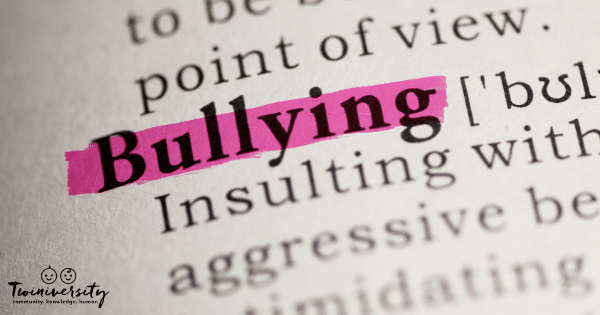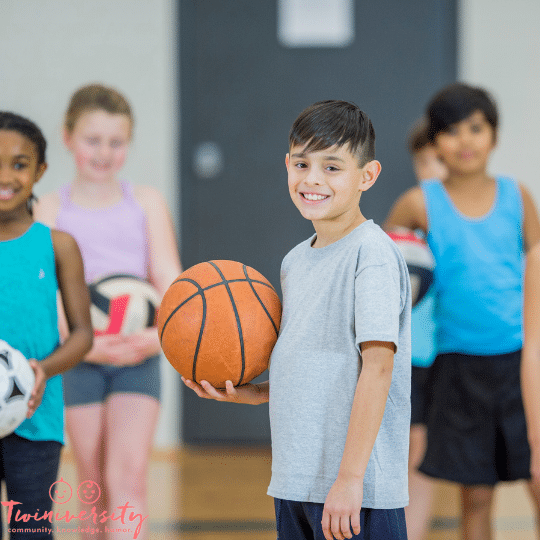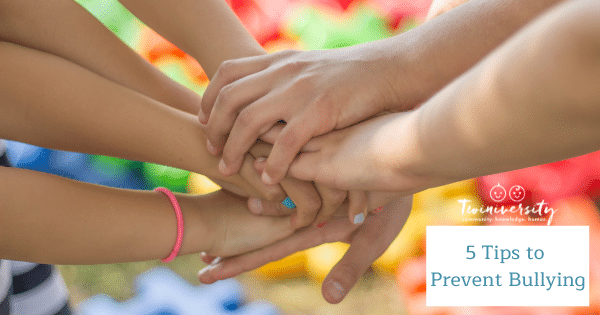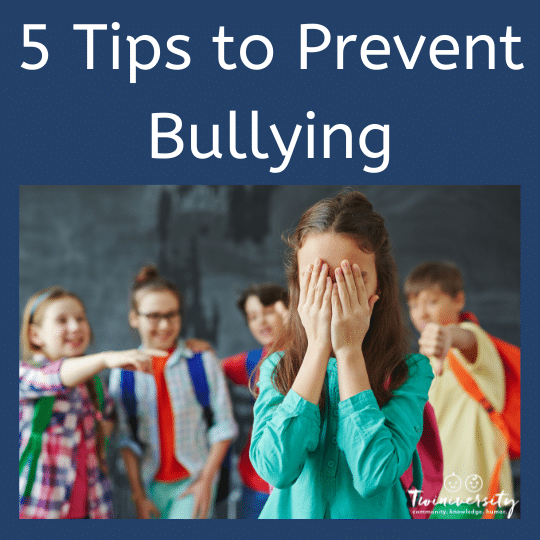Last updated on September 14th, 2023 at 06:58 pm
One of the top concerns among parents of school-aged children is how to prevent bullying. According to Julie Hertzog, director of PACER’s National Bullying Prevention Center, “One of every four school-aged children will be bullied this year – upwards of 13 million students.” With those staggering statistics, nearly every parent will have some experience with bullying.
Despite common myths, bullying is not a normal part of childhood or a rite of passage. Nor is it ever acceptable. By definition, bullying occurs repeatedly over time, is intended to harm another person, and occurs when there is a real or perceived imbalance of power. It can take many forms including verbal, physical, social/ emotional, or sexual, and cyberbullying.

We know now that bullying is a learned behavior that can develop in any child, regardless of sex, socioeconomic status, religion, or race. Fortunately, because bullying is a learned behavior, it can be changed with attention and intervention.
Here are five ways to help prevent your child from becoming a victim of bullying or a child who bullies:
1. Model Expected Behavior to Prevent Bullying
Children watch everything their parents say and do and then emulate what they observe. It’s important to model kindness and respect, show them how to accept differences, and demonstrate empathy. The way you interact with them, your partner, friends, and even other drivers in rush hour can shape the way your child interacts with others.
If your child notices that you are patient and use a kind tone despite frustrating circumstances, they are likely to do the same. However, if you lose your cool quickly or use a biting tone with your spouse, they will learn that instead. Always model the behavior you expect of your child. Otherwise, you may be inadvertently teaching them to bully.
Start off right on day one by refusing to be your own child’s bully. Pay attention to how you discipline and talk to your child as these interactions will influence their relationships in life.

2. Prevent Bullying with Communication and Connection
Connect with your child daily and discuss their feelings, friends, interests, and activities. These check-ins are the windows into what your child thinks and feels. This can often reveal struggles that may not be so obvious. Avoid judging your child and focus on offering what it is they need at the time, whether it is support, guidance, or just a hug. Celebrate successes of the day, and support your child when he is struggling.
If you suspect your child is a victim of bullying, reassure him that:
- It is not their fault
- It is not okay
- You are there to help
Assure your child that you will help them through this and then take the appropriate steps to address the problem.
On the other hand, if you suspect your child may be bullying others, use appropriate discipline and communication to correct the behavior. Model empathy while encouraging your child to consider the perspective of the other child and how bullying impacts the other child. Then you can collaborate to find a solution.
Be sure to set a reminder for yourself to follow up so these daily check-ins don’t get lost in the chaos of life.

Have you taken your expecting twins class yet? We offer a great class on demand so you can take it on your own schedule! There are so many video modules covering everything from your twins’ baby registry to your first week at home with twins!
Sign up today to get started before your twins arrive.
3. Encourage Extracurricular Activities to Prevent Bullying
Pay attention to your child’s favorite activities, hobbies, or interests. As your family schedule allows, encourage them to join in extracurricular activities that can boost their confidence and develop relationships with their peers. Doing something they enjoy and spending time with others is one of the best ways to help prevent bullying.
Dance classes, sports teams, gaming clubs, or wilderness groups, are all excellent and accessible ways to help your child build friendships. They will also develop feelings of acceptance and self-satisfaction making them less likely to tolerate bullying or feel compelled to bully others.

4. Teach Coping Strategies to Prevent Bullying
Children experience strong emotions ranging from anger and frustration to sadness just like adults. Learning to effectively talk about these emotions and ways to manage them is vital to prevent bullying.
Healthy outlets such as drawing, listening to music, participating in hobbies, and journaling can curb maladaptive behavior such as aggression and isolation, which put kids at risk of bullying or being bullied. If you have a child who has a hard time opening up, consider a shared journal that will allow them to write how they feel and you can respond.
If your child struggles to cope with his emotions, consider reaching out to a mental health professional for assistance. School counselors can help you address such concerns, and can help you access other resources if needed.

5. Communicate with Teachers/Leaders to Prevent Bullying
Develop strong relationships with your child’s teachers and any other leaders involved in your child’s life (i.e. coaches, instructors). These individuals often spend as much or more time with children as parents do. Therefore, they may notice changes in behavior or problems among groups of children and can alert you to bullying problems as they arise.
Additionally, strong parent-teacher relationships can help prevent bullying as it sends the message to your child that all of the adults in their life care about and support them. If your child is not comfortable discussing certain things with you, encourage them to seek a trusted adult who will also communicate with you on an as-needed basis.
October is National Bullying Prevention Month, and Wednesday, October 19 is Unity Day. On this day, wear orange to send a unified message that bullying is not acceptable in our society.
For additional information and resources, please visit:

Amber Shawver and her husband, George, are the proud parents of girl-boy-girl-boy quadruplets who debuted in 2012. Amber draws from her experiences working in childcare settings and as a school based behavioral consultant to manage raising quadruplets at home. Amber continues to practice school psychology part-time in an urban school district. She chronicles life raising quadruplets at Four to Adore. You can also find her on Facebook, Pinterest, and Twitter.
Related Articles
- What Your Twins Teacher Wants You To Know
- Twins In Junior High: Navigating Friendships
- 5 Tips to Deal With Aggressive Playmates and Your Twins
Latest Twiniversity Articles
Are You a New Twin Parent?
Check out Natalie Diaz’s book:
“What To Do When You’re Having Two
The Twin Survival Guide From Pregnancy Through the First Year”

In What to Do When You’re Having Two: The Twins Survival Guide from Pregnancy Through the First Year, national twins guru and founder of Twiniversity (and twin mom herself!) Natalie Diaz provides a no-holds-barred resource about life with twins, from pregnancy and birth all the way through your duo’s first year of life.
Accessible and informative, What to Do When You’re Having Two
is the must-have manual for all parents of twins.

Did you know we have a FREE Facebook group just for expecting twin parents? Hurry and join today to find support from expecting twin mamas who get it!









